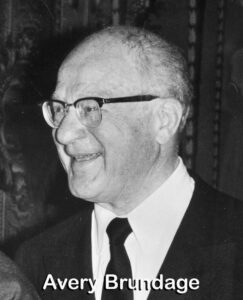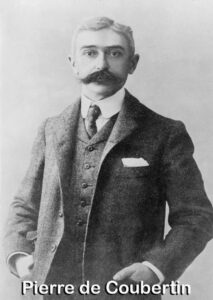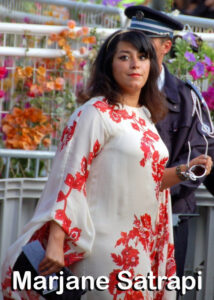 The ancient Olympic Games took place every four years between 776 BCE and 393 CE, and ceased in the third century because of “pagan” claims by a Christian Roman Emperor. The Frenchman Pierre de Coubertin reinvented the Games in 1896. He envisioned creating “modern” Games that celebrated excellence in body and mind. He proposed an Art and Architecture Olympic competition in 1906 to accompany the Games, premiering at the Stockholm Olympics in 1912.
The ancient Olympic Games took place every four years between 776 BCE and 393 CE, and ceased in the third century because of “pagan” claims by a Christian Roman Emperor. The Frenchman Pierre de Coubertin reinvented the Games in 1896. He envisioned creating “modern” Games that celebrated excellence in body and mind. He proposed an Art and Architecture Olympic competition in 1906 to accompany the Games, premiering at the Stockholm Olympics in 1912.
Montecito’s own Avery Brundage represented the US in the 1912 Olympics in the Pentathlon. This intelligent and ambitious competitor boasted an artist’s eye and an athlete’s body. After completing an engineering degree from the University of Illinois, he capitalized on the Chicago construction boom in the 1920s. His good fortune included marrying Chicago wealthy socialite Elizabeth Dunlop in 1927, and by 1929 he became President of the US Olympic Association. The International Olympic Committee (IOC) admired Brundage’s work; Brundage headed the US Olympic Association for twenty-four years.
Olympic Art Competitions
 Beginning in 1912 Olympic Games included gold, silver, and bronze medals in Olympic Art competitions. They called the five categories of the arts the Pentathlon of Creativity in the tradition of the Greek Muses: architecture, literature, music, painting, and sculpture. The Olympic committee formed an international art jury which formed the rules. A work must be original and sport inspired, and an artist submited many entries in many categories as well as competed in sports. Founder of the modern Olympics, de Coubertin, also a poet, won Gold in the category of literature for his “Ode to Sport.”
Beginning in 1912 Olympic Games included gold, silver, and bronze medals in Olympic Art competitions. They called the five categories of the arts the Pentathlon of Creativity in the tradition of the Greek Muses: architecture, literature, music, painting, and sculpture. The Olympic committee formed an international art jury which formed the rules. A work must be original and sport inspired, and an artist submited many entries in many categories as well as competed in sports. Founder of the modern Olympics, de Coubertin, also a poet, won Gold in the category of literature for his “Ode to Sport.”
The arts figured in the Olympics for over forty plus years. In the 38th year the category of Literature expanded to include Epic/Dramatic/Lyric forms. The category of Art expanded to paintings/prints/watercolors. The Committee added an Architecture category in 1928. Despite a slow start with artwork submissions, the Los Angeles Games in the late 1920s saw 384,000 visitors at the Museum of History, Science, and Art.
 However, the rules established by the International Olympic Committee in 1948 ran counter to the rules for sports competition. All competitors needed amateur status, and many of the artists who previously submitted work were career artists, and sold their works submitted during the Olympics. At the last years of the art competitions, Germany won the most gold medals for art, closely followed by a tie between Italy and France.
However, the rules established by the International Olympic Committee in 1948 ran counter to the rules for sports competition. All competitors needed amateur status, and many of the artists who previously submitted work were career artists, and sold their works submitted during the Olympics. At the last years of the art competitions, Germany won the most gold medals for art, closely followed by a tie between Italy and France.
Two sports medalists also won gold in arts categories. Sculptor and two dimensional artist Walter Winans won Gold for his sculpture “Harness Racer: an American Trotter.” He also won gold for Marksmanship. An Hungarian swimmer and architect, Alfred Hajos, won Silver in town planning and a Gold in swimming.
Olympic Art Connection Remains
 The connection between the Games and art remains enduring, as we saw in Paris’ 2024 Games opening events. The Olympic charter requires the host country to offer artistic cultural events when the Olympic village is open.
The connection between the Games and art remains enduring, as we saw in Paris’ 2024 Games opening events. The Olympic charter requires the host country to offer artistic cultural events when the Olympic village is open.
Artist Marjane Satrapi in 2024 created five fabulous nine meter long wool tapestries that hung in the spaces between the girders of the Eiffel Tower: images of two runners, one male, one female. For other public art spaces she created images of a javelin thrower, and images of two new Olympic entries, a breakdancer, and a skateboarder. Satrapi supervised the weaving of the tapestries by the famed Gobelins Manufactory established in the 17th century by Louis XIV. Furthermore, the IOC, in conjunction with the City of Paris, chose Los Angeles artist Alison Saar to design works in honor or the Olympic and Paralympic Games 2024. These sculptural works, honoring great women, “pass the torch,” linking the City of Lights to the City of Angels (Olympic Games 2028).
If you want to see more art, please check out the world’s largest collection of Olympic culture and heritage at the Olympic Museum of Lausanne Switzerland, with an emphasis on the values of respect, friendship, and excellence.
Pingback: David Hockney Poster for 1984 Olympic - Elizabeth Appraisals